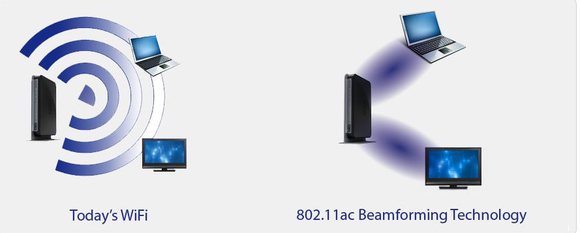802.11ac Beamforming
Devices that support beamforming focus their signals toward each client, concentrating the data transmission so that more data reaches the targeted device instead of radiating out into the atmosphere.
If the Wi-Fi client also supports beamforming, the router and client can exchange information about their respective locations in order to determine the optimal signal path. Any device that beamforms its signals is called a beamformer, and any device that receives beamformed signals is called a beamformee.
Mathematically, the ability to steer energy is represented by the steering matrix, which is given the letter Q in 802.11ac.
However, in 802.11ac Wave2, beam forming will be a standard feature on the chips and all vendors will offer it as something that’s table stakes. In reality, Broadcom has already implemented single user beam forming into its silicon, giving all the Broadcom-based Wi-Fi vendors that capability today. Wave 2 is when multi-user beam forming becomes a standard that will close the gap even more.
If one device (such as the router) supports beamforming, but the other (such as the Wi-Fi adapter in your router) doesn’t, they’ll still work together. They just won’t take advantage of the technology.
Devices that support beamforming focus their signals toward each client, concentrating the data transmission so that more data reaches the targeted device instead of radiating out into the atmosphere.
If the Wi-Fi client also supports beamforming, the router and client can exchange information about their respective locations in order to determine the optimal signal path. Any device that beamforms its signals is called a beamformer, and any device that receives beamformed signals is called a beamformee.
Mathematically, the ability to steer energy is represented by the steering matrix, which is given the letter Q in 802.11ac.
However, in 802.11ac Wave2, beam forming will be a standard feature on the chips and all vendors will offer it as something that’s table stakes. In reality, Broadcom has already implemented single user beam forming into its silicon, giving all the Broadcom-based Wi-Fi vendors that capability today. Wave 2 is when multi-user beam forming becomes a standard that will close the gap even more.
Multi-User (MU) Beamforming
MU-MIMO features prominently in the later update of the 802.11ac wireless specification (802.11ac Wave 2)
By simplifying beamforming to use one method of channel sounding,
802.11ac will enable wider use of standards-based beamforming. More
significant, however, is the inclusion of multi-user (MU) MIMO beamforming
in 802.11ac. Prior to the introduction of multi-user beamforming, all
802.11 devices could send a transmission to only one device at a time.
Just as Ethernet switches reduced the scope for collisions from a large
network down to a single port, multi-user MIMO reduces the spatial
collision domain. By using MU-MIMO, an AP may transmit to multiple
receiving stations simultaneously.
Due to the need for sophisticated antenna systems and signal
processing, MU-MIMO in 802.11ac can be used only in the downstream
direction, from an AP to multiple client devices.
One important capability that MU-MIMO brings to 802.11ac is its
support of single-stream devices. Prior to 802.11ac, beamforming worked to
increase the signal-to-noise ratio of a link to a single device, but the
devices on the network often limited its benefits. Many small
battery-powered devices are capable of only a single spatial stream, and
thus receive only limited benefits from single-user MIMO. With 802.11ac’s
multi-user MIMO, a single transmission time can be used to send frames to
multiple single-stream receivers. The 802.11ac standard allows up to four
different receiver groups within one MU-MIMO transmission.
Multi-user MIMO can transmit simultaneously to multiple
single-stream devices, which enables the network to more efficiently
serve increasingly common battery-powered devices such as phones and
tablets.
If one device (such as the router) supports beamforming, but the other (such as the Wi-Fi adapter in your router) doesn’t, they’ll still work together. They just won’t take advantage of the technology.




No comments:
Post a Comment